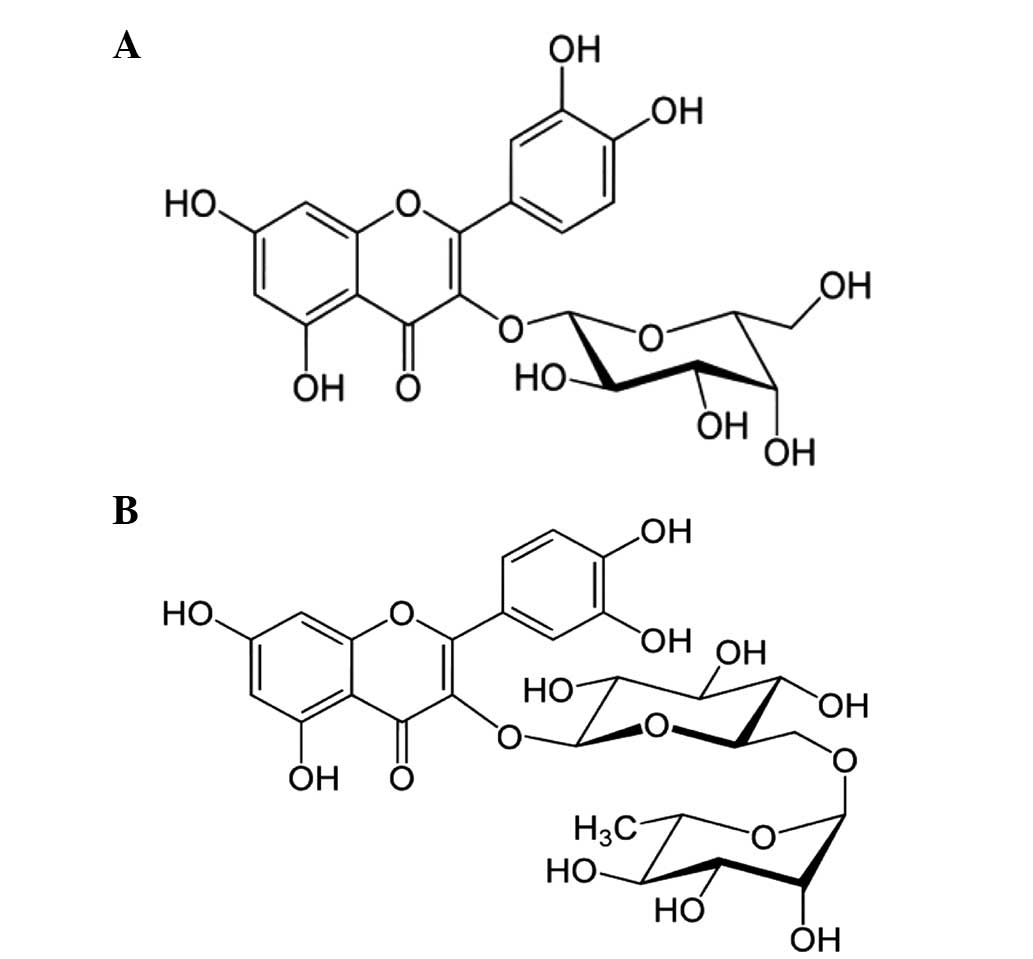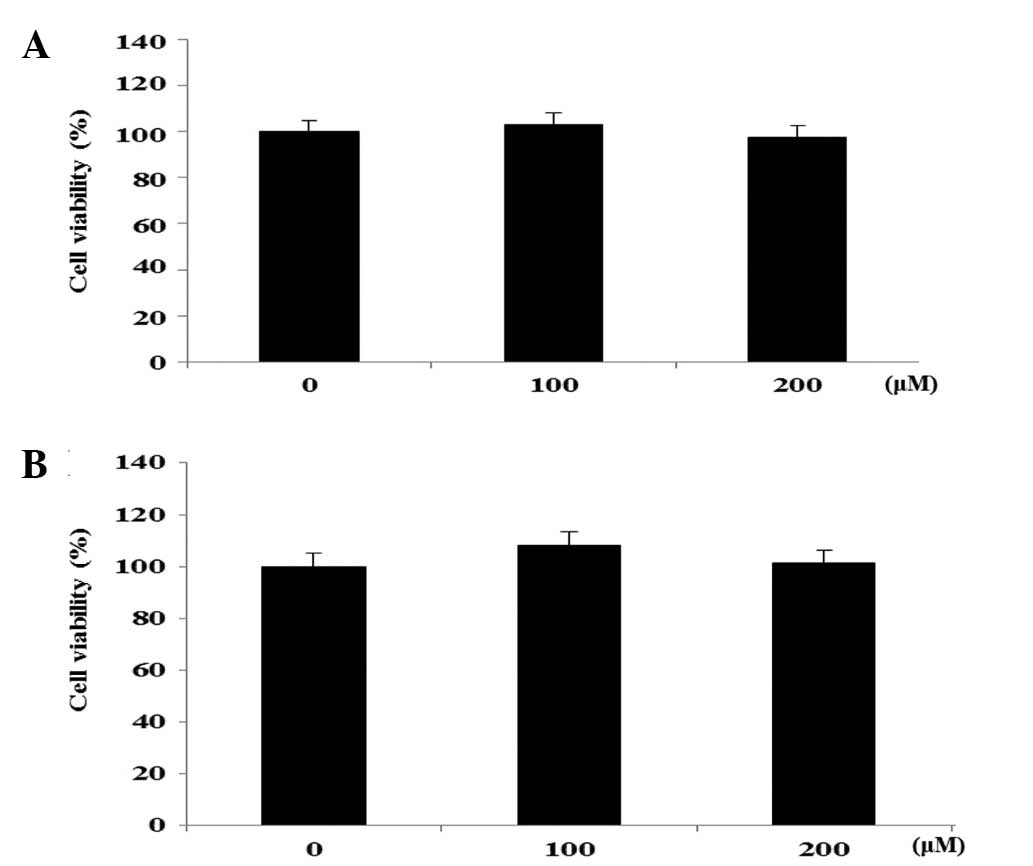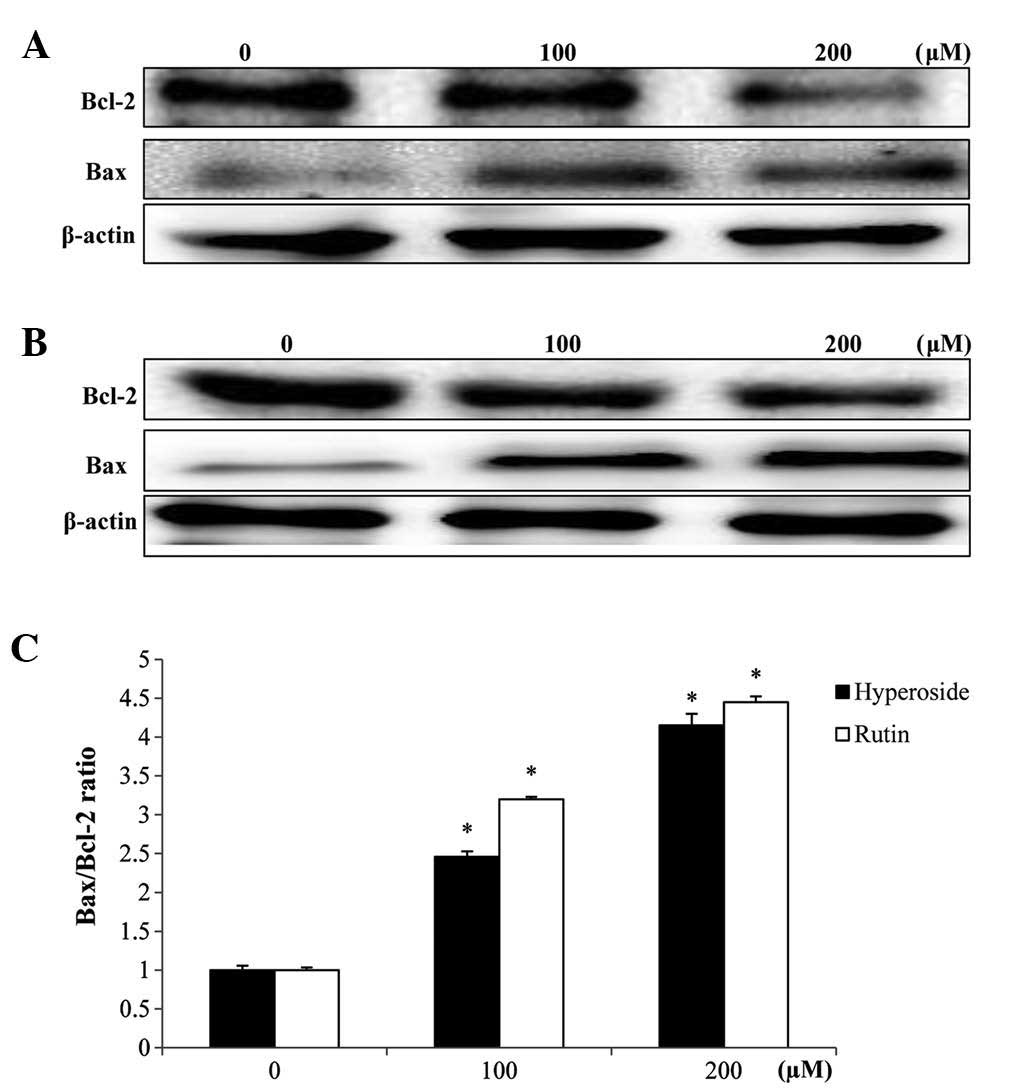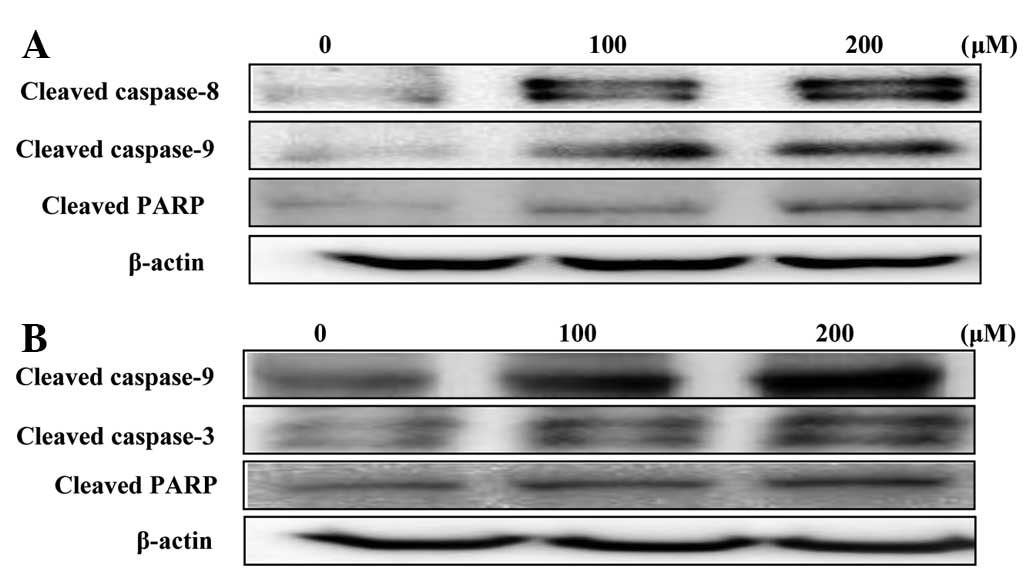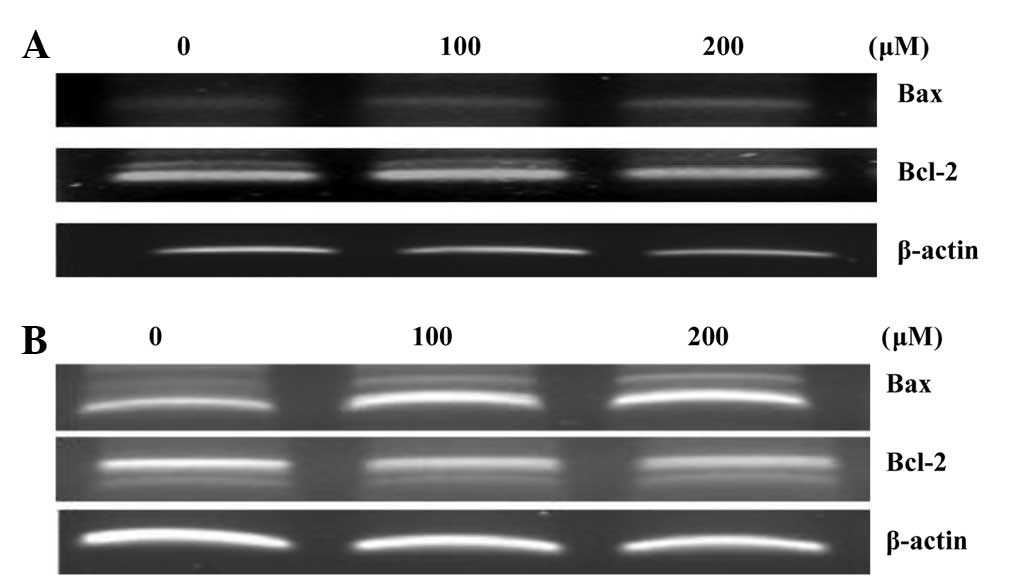Hyperoside and rutin of Nelumbo nucifera induce mitochondrial apoptosis through a caspase-dependent mechanism in HT-29 human colon cancer cells
- Authors:
- Published online on: February 18, 2016 https://doi.org/10.3892/ol.2016.4247
- Pages: 2463-2470
Abstract
Introduction
Colorectal cancer is the second most prevalent malignancy and the leading cause of cancer-associated mortality worldwide (1). The incidence rates of colorectal cancer have been rapidly increasing in Asia due to smoking, the increased tendency for being overweight and the excessive consumption of meat and alcohol (2,3). Multiple phytochemicals have been identified through epidemiological studies as potential cancer-fighting agents that may be obtained from commonly consumed fruits and vegetables (4,5).
Although the toxicity of chemotherapy is a major obstacle for the successful treatment of cancer, chemo and radiation therapies are the major tools for cancer treatment, at present. For these reasons, the identification of safe components with a high selectivity for killing cancer cells from natural sources is required (6,7). Certain secondary metabolites from natural plants exhibit biological activities, which are considered to be critical for maintaining human health. The development of high quality varieties that contain increased levels of bioactive components may improve the medicinal value of plants (8).
Nelumbo nucifera, the lotus, is an aquatic perennial plant that is commonly cultivated in water gardens in tropical Asia and Australia (9). The flowers, seeds, young leaves, rhizomes and roots of N. nucifera are used for edible and medicinal sources in Asian regions. The roots of N. nucifera have been identified as being rich in dietary fiber, vitamins B1, B2, B6 and C, potassium, phosphorus, copper and manganese (10). N. nucifera contains biologically effective flavonoids, including kaempferol, quercetin, rutin and hyperoside, exhibits anti-inflammatory, -oxidant, -fungal, -microbial and tyrosinase inhibitory activities, and has protective properties in carbon tetrachloride-induced liver damage (11–18).
In a previous report, the anti-proliferative effect of a 70% ethanol extract of the root of N. nucifera on HT-29 human colon cancer cells was investigated, which was based on cell viability, Hoechst 33342 nuclear staining, apoptosis analysis, western blotting and reverse transcription-polymerase chain reaction (RT-PCR) analyses. N. nucifera was indicated to inhibit the growth of colon cancer cells by the activation of the mitochondria-dependent apoptotic pathway via the modulation of Bcl-2-associated X protein (Bax) and B-cell lymphoma 2 (Bcl-2) expression (19).
Flavonoids are polyphenol compounds that are commonly identified in plants and have gained considerable interest and attention in recent years, due to the bioactive functions they possess. Among these flavanoids, hyperoside and rutin are composed of flavan-3-ol glycosidic linkages, which are molecules of joined together glucose and glucose and rhamnose, respectively (Fig. 1). Despite evidence for the numerous biological effects of flavan-3-ols, the anti-cancer effects of hyperoside and rutin-induced apoptosis have not been investigated.
Numerous previous studies aimed to identify anticancer components from natural sources (20–23). Therefore, the effects of hyperoside and rutin on the proliferation and apoptosis in HT-29 human colon cancer cells, through activity-guided fractionation and isolation methods, are investigated in the present study.
Materials and methods
Chemicals and reagents
Propidium iodide (PI) and 3-(4,5-dimethylthiazol-2-yl)-2,5-diphenyltetrazolium bromide (MTT) were purchased from Merck Millipore (Darmstadt, Germany) and Sigma-Aldrich (St. Louis, MO, USA), respectively. Primary antibodies included anti-mouse β-actin (sc-47778), and rabbit monoclonal anti-Bcl-2 (sc-492) and anti-Bax (sc-493) (dilution, 1:1,000; Santa Cruz Biotechnology, Inc., Dallas, TX, USA), and were purchased from Santa Cruz Biotechnology, Inc. (Dallas, TX, USA). Rabbit monoclonal antibodies against cysteinyl aspartate-specific cleaved caspase-3 (9661), −8 (8592) and −9 (7237) and poly-(ADP-ribose) polymerase (PARP; 5625) antibodies were purchased from Cell Signaling Technologies, Inc. (Danvers, MA, USA). Secondary antibodies included goat anti-rabbit IgG-horseradish peroxidase (HRP; sc-2004) and goat anti-mouse IgG-HRP (sc-2005) (dilution, 1:2,000), and were purchased from Santa Cruz Biotechnology, Inc. (Dallas, TX, USA). All other chemicals and reagents were of the highest analytical grade.
Plant materials
The roots of N. nucifera were purchased at Nonghyup Hanaro mart (Yangjae, Seoul, Korea) in May 2012 (19). Roots were dried using an automatic food dryer (LD-528WG; L'equip Co., Ltd., Seoul, Korea) and then were ground to fine powders.
Instrumental analysis
The uncorrected melting points (MPs) were determined using Mitamura-Riken Kogyo MEL-TEMP apparatus (Mitamura Riken Kogyo Inc., Tokyo, Japan). Ultraviolet-visible (UV-Vis) spectra were obtained using a JP/U3010 spectrometer (Hitachi, Ltd.,Tokyo, Japan) and infrared (IR) spectra were obtained on a FT/IR-5300 spectrometer (Jasco International Co., Ltd., Tokyo, Japan). The electron ionization (EI) and fast-atom bombardment-mass spectrometry (FAB-MS) spectra were obtained on a JMS-700 spectrometer (JEOL, Ltd., Tokyo, Japan). The nuclear magnetic resonance (NMR) spectra were measured on an Avance-500 spectrometer (500 MHz; Bruker Corporation, Billerica, MA, USA), and the chemical shifts were referenced against tetramethylsilane (TMS) and deuterium dimethylsulfoxide (DMSO-d6) as NMR solvents. Column chromatography (CC) was run on a silica gel 60 (70–230 or 230–400 mesh; Merck Millipore) and Sephadex LH-20 (25–100 mm; GE Healthcare Life Sciences, Uppsala, Sweden). Thin layer chromatography (TLC) was performed on silica gel 60F254 and RP-18254S plates. TLC plates were visualized using UV light, stained with FeCl3, aniline hydrogen phthalate and 20% H2SO4, and then heated at 70–80°C for 5 sec.
Extraction and isolation of compounds
The dried powdered roots of N. nucifera (800 g) were extracted 3 times using 70% ethyl alcohol (EtOH) under 70–80°C reflux conditions to produce 92 g extracts. The 70% EtOH extract was suspended in water and successively partitioned with n-hexane, dichloromethane (CH2C12), ethyl acetate (EtOAc) and n-butanol (n-BuOH) to yield solvent-soluble fractions. A 12-g portion of the EtOAc fraction was subjected to silica gel CC and eluted with CH2C12-methanol (MeOH) mixtures with increasing concentrations of MeOH (0, 20, 50, 70 and 100%) to produce 12 fractions (E-01-E12). Fraction E-08 was submitted to silica gel CC using CH2C12-MeOH, in the ratios of 1:9, 1:7, 1:5 and 1:2, to yield fifteen sub-fractions. The sub-fractions E-08-8 (110 mg) and E-08-11 (180 mg) were successively purified using Sepadex LH-20 CC and vacuum liquid chromatography (VLC) with MeOH to produce hyperoside (28 mg) and rutin (34 mg).
Cell culture
The human colon cancer HT-29 cell line was obtained from the Korean Cell Line Bank (Seoul, Korea). The normal colon epithelium FHC cell line was obtained from the American Type Culture Collection (Manassas, VA, USA). HT-29 cells were maintained in Roswell Park Memorial Institute (RPMI)-1640 medium, supplemented with 10% Invitrogen fetal bovine serum (FBS; Thermo Fisher Scientific, Inc., Waltham, MA, USA), 100 units/ml penicillin and 100 µg/ml streptomycin (Gibco; Thermo Fisher Scientific, Inc.). FHC cells were maintained in Dulbecco's modified Eagle medium nutrient mixture F-12 (DMEM)/F-12, which contained 10 ng/ml cholera toxin, 0.005 mg/ml insulin, 0.005 mg/ml transferrin, 100 ng/ml hydrocortisone, supplemented with 10 % FBS, 100 units/ml penicillin and 100 µg/ml streptomycin. All of the cell lines were cultured in a humidified chamber with 5% CO2 at 37°C. Cell counts were performed using a hemocytometer from Hausser Scientific (Horsham, PA, USA).
Cell viability assay
The cytotoxic effects of hyperoside and rutin on the HT-29 and FHC cell lines were estimated colorimetrically using the MTT method, which is based on the reduction of tetrazolium salt by mitochondrial dehydrogenase in viable cells (24). Briefly, the cells were seeded in a 96-well plate (density, 1×104 cells/ml) and were then treated with hyperoside and rutin at final concentrations of 0, 100 and 200 µm. Subsequent to 24 h incubation, MTT solution was added to each well at a final concentration of 0.4 mg/ml. Subsequent to 2 h of incubation, the supernatants were aspirated and replaced with 150 µl of dimethyl sulfoxide (DMSO) to dissolve the formazan product. The absorbance at 570 nm was then read using a spectrophotometric plate reader (model 550; Bio-Rad Laboratories, Inc., Hercules, CA, USA). The results were calculated as percentages of the unexposed control.
Nuclear staining with Hoechst 33342
The nuclear morphology of the cells was observed using Hoechst 33342 DNA-specific blue fluorescent dye. The viable cells were stained homogeneously, whereas the apoptotic cells that had undergone chromatin condensation or nuclear fragmentation were not stained (25). The HT-29 cells were treated with hyperoside and rutin at the various concentrations. Cells were then fixed for 30 min at 37°C in 100% MeOH, washed with PBS, and stained with 2 µg/ml Hoechst 33342 (Sigma-Aldrich). The cells were observed under a BX51 fluorescence microscope and images were captured with a DP70 camera (Olympus Corporation, Tokyo, Japan).
Apoptosis analysis
An Annexin V/PI double staining assay was carried out in order to distinguish between the early and late apoptosis stages. The stages were determined using an ApoScan™ Annexin V-FITC apoptosis detection kit (BioBud, Seoul, Korea) in hyperoside and rutin-treated HT-29 cells. The cells were trypsinized, harvested and washed with PBS. The cells were resuspended in 1X binding buffer (500 µl) and incubated with 1.25 µl of Annexin V-fluorescein isothiocyanate (concentration, 200 µg/ml) at room temperature for 15 min. The supernatant was then removed following centrifugation at 400 × g for 10 min. The cells were resuspended in 500 µl of 1X binding buffer and the cell suspensions were then stained with 10 µl PI (concentration, 30 µg/ml) at 4°C in the dark. Fluorescence was quantified using FACSCalibur flow cytometry (BD Biosciences, Franklin Lakes, NJ, USA). The levels of early and late apoptosis were determined as the percentage of Annexin V+/PI− or Annexin V+/PI+ cells, respectively.
Western blot analysis
Western blot analyses were performed, as previously described (20). The cells were cultured, harvested and lysed on ice for 30 min in lysis buffer (120 mM NaCl; 40 mM Tris, pH 8.0; 0.1% nonyl phenoxypolyethoxylethanol) and were then centrifuged at 13,000 × g for 15 min. Lysates from each sample were mixed with 5X sample buffer [0.375 M Tris-HCl; 5% sodium dodecyl sulfate (SDS); 5% β-mercaptoethanol; 50% glycerol; 0.05% bromophenol blue, pH 6.8] and were then heated to 95°C for 5 min. Equal amounts of protein were separated by 12% SDS-polyacrylamide gel electrophoresis (SDS-PAGE) and were transferred onto a nitrocellulose membrane. The membranes were then washed with Tris-buffered saline (10 mM Tris, 150 mM NaCl) containing 0.05% Tween-20 (TBST), and were then blocked in TBST containing 5% nonfat dried milk. The membranes were incubated with respective specific primary antibodies overnight at 4°C. Subsequent to 3 washes in TBST, the membranes were incubated with the appropriate secondary antibodies coupled to HRP for 1 h at room temperature. The membranes were then washed 3 times in TBST with 15 min between each step, and protein detection was performed using an enhanced chemiluminescence western blotting detection kit. The data of specific protein levels are presented as multiples relative to the control.
RT-PCR
Cells were treated with dihydroxyflavone at 10 µg/ml for various lengths of time, and were treated with hyperoside and rutin at final concentrations of 0, 100 and 200 µm. Total RNA was isolated from the cells using Gibco TRIzol® reagent (Thermo Fisher Scientific, Inc.), according to the manufacturer's protocol, and quantitated using spectrophotometry. Total RNA (5 µg) was reverse transcribed into cDNA by incubating with Invitrogen SuperScript®™ RNase H reverse transcriptase (Thermo Fisher Scientific, Inc.). PCR was conducted in a reaction composed of 40 µg of 1.25X reacting mix, 1 µl enzyme mix, 1 µl forward primer (200 nM), 1 µl reverse primer (200 nM) and RNA. cDNA was performed with following conditions: cDNA synthesis at 45°C for 30 min, followed by denaturation at 94°C for 2 min. A total of 40 cycles of PCR amplification were then performed with following conditions: 94°C for 15 sec, 60°C for 30 sec, and 68°C for 1 min. The last cycle was followed by final extension step at 72°C for 5 min.
The primer pairs (Bionics, Seoul, Korea), forward and reverse, respectively, were as follows: β-actin, 5-CCTCTATGCCAACACAGTGC-3 and 5′-ATACTCCTGCTTGCTGATCC-3; Bcl-2, 5-AGCTGCACCTGACGCCCTTCA-3′ and 5-AGCCAGGAGAAATCACAGAGG-3; Bax,5-ATGGACGGGTCCGGGGAGCAG-3 and 5-CAGTTGAAGTTGCCGTCAGA-3. PCR was performed for 40 cycles. Temperature cycling was initiated with each cycle, using the Takara PCR Thermal Cycler Dice (Takara Bio, Inc., Otsu, Japan), as follows: β-actin, 98°C for 10 sec (denaturation), 55°C for 30 sec (annealing), 72°C for 1 min (extension); Bcl-2, 98°C for 10 sec, 60°C for 30 sec, 72°C for 1 min; Bax, 98°C for 10 sec, 60.5°C for 30 sec and 72°C for 1 min. The amplified products were resolved on 1% agarose gels, stained with ethidium bromide (Sigma-Aldrich) and photographed under ultraviolet light using a Mini BIS image analysis system (DNR Bio-Imaging Systems Ltd., Jerusalem, Israel).
Statistical analyses
SPSS software version 22.0 (IBM SPSS, Armonk, NY, USA) was used to analyse the data. The results were subjected to analysis of variance, followed by the Tukey range test in order to analyze the differences between conditions. In each case, the P<0.05 was considered to indicate a statistically significant difference. All measurements were made in triplicate, and all values are given as the mean ± standard deviation.
Results
Isolation of pure compounds
The dried and ground compounds of the root of N. nucifera were extracted with 70% EtOH and successively fractionated using n-hexane, CH2C12, EtOAc and n-BuOH to identify the cytotoxic solvent-soluble fractions of the HT-29 human colon cancer cell line, through the activity-guided fractionation and isolation method (26) Of the fractions, the EtOAc-soluble fraction of N. nucifera demonstrated a strong cytotoxicity with an half maximal inhibitory concentration value of 26.7±0.8 µg/ml (data not shown), based on the cell viability assay. CC was applied to the EtOAc-soluble fraction for the isolation of pure compounds. The chemical structures of the pure compounds were characterized as hyperoside and rutin based on physicochemical methods, co-TLC, MP, FAB-MS, UV-Vis, FT-IR, and proton (1H)- and 13C-NMR spectral data (Fig. 1).
Spectral data of hyperoside
The spectral data were as follows: Pale yellowish powder (MeOH); FeCl3 and aniline hydrogen phthalate color reaction, positive; MP, 197–202°C; UV (MeOH) λmax, 280 (4.54), 364 (4.36) nm; IR vmax (KBr), cm−1: 3,380 (OH), 1,660 (α,β-unsaturated C=O), 1,612, 1,490 (aromatic C=C), 1,240 (aromatic C-O), 1,062 and 1,012 (glycosidic C-O); FAB-MS, 465 [M+H]+ m/z; 1H-NMR (500 MHz, DMSO-d6): δ 8.27 (1H, s, 5-OH), 7.66 (1H, dd, J=2.1, 8.4, H-6′), 7.56 (1H, d, J=2.1, H-2′), 6.82 (1H, d, J=8.4), 6.43 (1H, d, J=1.9, H-8), 6.22 (1H, d, J=1.9, H-6) and 5.36 (1H, d, J=7.6, anomeric proton); 13C-NMR (125 MHz, DMSO-d6): δ 181.4 (C-4), 164.4 (C-2), 162.4 (C-7), 161.0 (C-5), 160.1 (C-7), 156.6 (C-9), 150.2 (C-4′), 145.2 (C-3′), 121.2 (C-1′), 119.1 (C-6′), 116.1 (C-5′), 113.2 (C-2′), 105.1 (C-10), 103.1 (C-3), 99.1 (C-8), 97.7 (Glc-1″), 77.0 (Glc-5″), 76.7 (Glc-2″), 76.1 (Glc-3″), 70.1 (Glc-4″) and 60.4 (Glc-6″).
Spectral data of rutin
The spectral data were as follows: Pale yellowish powder (MeOH); FeCl3 and aniline hydrogen phthalate color reaction, positive; MP, 202–204°C; UV λmax (MeOH), 268 (4.50), 375 (4.26) nm; IR vmax (KBr), cm−1: 3,360 (OH), 1,670 (α,β-unsaturated C=O), 1,600, 1,512 (aromatic C=C), 1,240 (aromatic C-O), 1,060 and 1,015 (glycosidic C-O); FAB-MS, 611 [M+H]+m/z; 1H-NMR (500 MHz, DMSO-d6): δ 7.68 (1H, d, J=2.1, H-2′), 7.54 (1H, dd, J=2.1, 8.4, H-6′), 6.85 (1H, d, J=8.4, H-5′), 6.40 (1H, d, J=1.8, H-8), 6.18 (1H, d, J=1.8, H-6), 5.31 (1H, d, J=7.6, anomeric proton) and 0.92 (3H, d, J=5.5, Rha-6); 13C-NMR (125 MHz, DMSO-d6), δ 177.24 (C-4), 163.97 (C-7), 161.09 (C-9), 156.50 (C-5), 156.30 (C-2), 148.29 (C-4′), 144.63 (C-3′), 133.16 (C-3), 121.48 (C-6′), 121.05 (C-1′), 116.15 (C-5′), 115.11 (C-2′), 103.83 (C-10), 101.04 (C-Glc″), 100.64 (C-Rha″), 98.58 (C-6), 93.49 (C-8), 76.30 (Rha-5″), 75.77 (Glc-5″), 73.95 (Glc-2″), 71.70 (Rha-4″), 70.43 (Rha-3″), 70.25 (Rha-2″), 69.86 (Glc-4″), 68.14 (Rha-5″), 66.89 (Glc-6″) and 17.63 (Rha-6″).
Cell viability in FHC and HT-29 cell lines
In the preliminary investigation, the EtOAc-soluble fractions of the roots of N. nucifera were observed to exhibit significant cytotoxicity on the HT-29 human colon cancer cells (IC50, 26.7±0.8 µg/ml). A bioactivity-guided isolation of the cytotoxic EtOAc-soluble fraction on HT-29 human colon cancer cells was performed, leading to the isolation of 2 flavonol glycosides, hyperoside and rutin. The effects of hyperoside and rutin on the growth of FHC human colon normal cells and HT-29 human colon cancer cells was examined using an MTT assay. The cells were exposed to various concentrations (0–200 µm) of the flavanoids for 24 h, and the cytotoxicity was determined as a percentage of the viable treated cells in comparison with the number of viable untreated control cells. As shown in Fig. 2, hyperoside and rutin did not affect the proliferation on FHC colon normal cells in a dose-dependent manner. However, hyperoside and rutin significantly inhibited the proliferation of HT-29 human colon cancer cells in a dose-dependent manner. Subsequent to 24 h of exposure, hyperoside and rutin induced 25.6 and 37.1% growth inhibition at the concentration of 200 µm, respectively (Fig. 3). Therefore, hyperoside and rutin were selected for the subsequent experiments from the flavonoids isolated from N. nucifera.
Induction of apoptosis in HT-29 cells
The apoptogenic properties of the compounds were investigated through morphological changes in HT-29 cells. Nuclear Hoechst 33342 staining was performed in order to determine whether the anti-proliferative effect of hyperoside and rutin was due to apoptosis. As shown in Fig. 4, HT-29 cells that were treated with hyperoside and rutin exhibited a number of morphological changes, including cell shrinkage, condensed chromatin, rounding, blebbing and an increased density of apoptotic bodies compared with the untreated control cells. The number of apoptotic cells increased in a dose-dependent fashion.
Effects on apoptosis in HT-29 cells
In order to quantify the percentage of apoptotic cells, flow cytometry analysis was performed using double staining with Annexin V and PI. The Annexin V−/PI− population was considered to account for unaffected cells, the Annexin V+/PI− population for early apoptosis, Annexin V+/PI+ for late apoptosis and Annexin V−/PI+ for necrosis. The results showed that the treatment of the cells with hyperoside and rutin significantly increased the percentage of apoptotic cells compared with untreated control cells (Fig. 5). The total apoptotic cell populations of hyperoside and rutin were increased by 52.4 and 56.5% at 200 µm, respectively, compared with the control. These results indicate that hyperosde and rutin may induce apoptosis in HT-29 human colon cancer cells.
Effects on Bcl-2 and Bax expression
In order to study the effects of hyperoside and rutin on apoptosis in HT-29 cells, the expression levels of apoptosis regulatory proteins, including Bcl-2 and Bax were examined. The mitochondrial pathway is an important apoptosis pathway as it regulates the apoptotic cascade via a convergence of signaling at the mitochondria. Bcl-2 interacts with the mitochondrial plasma membrane and prevents mitochondrial membrane pores from opening during apoptosis, blocking the signals of apoptotic factors (22). As shown in Fig. 6, hyperoside and rutin increased Bax expression but decreased the expression of Bcl-2, each in a dose-dependent manner. Also, a densitometric analysis of the bands showed that hyperoside and rutin caused a dose-dependent increased the Bax/Bcl-2 ratio (Fig. 6C).
Effects on caspase expression
The disruption of the mitochondrial plasma membrane by hyperoside and rutin was followed by the activation of the cleaved caspases-3, 8 and 9 and target protein PARP, respectively (Fig. 7). These results, together with the Bax/Bcl-2 ratio suggested that hyperoside and rutin may induce apoptosis through the regulation of apoptosis-associated protein expression in HT-29 human colon cancer cells.
RT-PCR analysis
RT-PCR analysis was used to examine any alterations in Bax and Bcl-2 expression. During apoptosis, Bcl-2, a negative regulator of apoptosis, prevents mitochondrial membrane pores from opening; however, the positive regulator, Bax, produces the opposite effect. As a result, hyperoside and rutin increased Bax expression, but decreased the expression of Bcl-2 in a concentration-dependent manner (Fig. 8).
Discussion
Uncontrolled proliferation is a significant biological feature of cancer cells, and the inhibition of cell proliferation may achieve the arrest of tumor growth (27). Colorectal cancer is the second leading cause of cancer-associated mortalities in the Western world (28). Colorectal cancer is hypothesized to arise as a result of the transformation of normal colonic epithelial cells into a colorectal carcinoma, as an adenomatous polyp. Increased understanding of cancer has led to the development of numerous novel anticancer agents and associated natural therapies, a variety of which clinically target the inhibition of cancer cells, but not normal cells; however, numerous anticancer agents are also toxic to normal cells. Therefore, novel agents that are derived from natural sources, which specifically target colorectal cancer but have a decreased toxicity for normal colonic epithelial cells, hold enormous potential (20).
Apoptosis is an extremely important phenomenon due to the maintenance of cellular homeostasis by the regulation of cell division and cell death (29). The mitochondrial-associated pathway is regulated by anti-apoptotic members, including Bcl-2 and Bcl-2-like 1, and pro-apoptotic members, including Bax, Bcl-2-antagonist/killer 1, BH3 interacting domain death agonist, Bcl-2 associated agonist of cell death and Bcl-2-like 11, of the Bcl-2 family. The anti-apoptotic proteins on the outer membranes of the mitochondria maintain the integrity of the mitochondria, through inhibiting apoptosis in the presence of various apoptotic stimuli (30). In response to an apoptotic stimulus, the pro-apoptotic proteins reside in the cytosol and translocate to the mitochondria, which leads to the formation of membrane pores at the mitochondrial membranes (31). The data in the present study showed that apoptosis with hyperoside and rutin is associated with the upregulation of Bax protein and the downregulation of Bcl-2 expression, each in a dose dependent manner.
Caspase-3 is one of the key executioners of apoptosis, and is either partially or totally responsible for the proteolytic cleavage of numerous proteins, including PARP (32). PARP is an important factor that allows cells to maintain viability, but the cleavage of PARP facilitates cellular disassembly and acts as a major marker for caspase-dependent apoptosis (33). The cleaved form of PARP was detected in hyperoside and rutin-treated HT-29 cells. These data indicate that hyperoside and rutin induce apoptosis via the mitochondrial pathway. To the best of our knowledge, the present study is the first to demonstrate the cytotoxic effects of hyperoside and rutin on HT-29 human colon cancer cells, and provides a possible mechanism for this activity. The present study indicates that hyperoside and rutin may be the promising candidates for chemotherapy of colon cancer.
References
|
Kwon YS, Lee DH, Lee KS and Nam KS: Effects of deep-sea water on inhibition of metastatic regulators expression in human colorectal adenocarcinomas by chitosan oligosaccharide. J Chitin Chitosan. 4:229–234. 2012. | |
|
Jemal A, Bray F, Center MM, Ferlay J, Ward E and Forman D: Global cancer statistics. CA Cancer J Clin. 61:69–90. 2011. View Article : Google Scholar : PubMed/NCBI | |
|
Hur SK, Kim SS, Heo YH, Ahn SM, Lee BG and Lee SK: Effects of the grapevine shoot extract on free radical scavenging activity and inhibition of pro-inflammatory mediator production in RAW264.7 macrophages. Biomol Ther. 9:188–193. 2001. | |
|
Jemal A, Siegel R, Xu J and Ward E: Cancer statistics, 2010. CA Cancer J Clin. 60:277–300. 2010. View Article : Google Scholar : PubMed/NCBI | |
|
Siegel RL, Jemal A and Ward EM: Increase in incidence of colorectal cancer among young men and women in the United States. Cancer Epidemiol Biomarkers Prev. 18:1695–1698. 2009. View Article : Google Scholar : PubMed/NCBI | |
|
Møller H, Sandin F, Robinson D, Bray F, Klint S, Linklater KM, Lambert PC, Påhlman L, Holmberg L and Morris E: Colorectal cancer survival in socioeconomic groups in England: Variation is mainly in the short term after diagnosis. Eur J Cancer. 48:46–53. 2012. View Article : Google Scholar : PubMed/NCBI | |
|
Kopetz S, Chang GJ, Overman MJ, Eng C, Sargent DJ, Larson DW, Grothey A, Vauthey JN, Nagorney DM and McWilliams RR: Improved survival in metastatic colorectal cancer is associated with adoption of hepatic resection and improved chemotherapy. J Clin Oncol. 27:3677–3683. 2009. View Article : Google Scholar : PubMed/NCBI | |
|
Hyun JW and Chung HS: Medicinal plants with cytotoxic and antioxidative activity. Recent Progress in Medicinal Plants. Sharma AK, Singh VK, Govil JN and Goyal NK: 12:(1st). Studium Press LLC. (Houston, TX). 193–202. 2006. | |
|
Shen-Miller J, Schopf JW, Harbottle G, Cao RJ, Ouyang S, Zhou KS, Southon JR and Liu G: Long-living lotus: Germination and soil γ-irradiation of centuries-old fruits, and cultivation, growth, and phenotypic abnormalities of offspring. Am J Bot. 89:236–247. 2002. View Article : Google Scholar : PubMed/NCBI | |
|
Park SH, Ham TS and Han JH: Nutritional contents of beverage from lotus root and evaluation of its physiological function in aorta relation. Kor J Ori Med Physiol Pathol. 19:490–494. 2005. | |
|
Jung HA, Kim JE, Chung HY and Choi JS: Antioxidant principles of Nelumbo nucifera stamens. Arch Pharm Res. 26:279–285. 2003. View Article : Google Scholar : PubMed/NCBI | |
|
Li S, Zhang Z, Cain A, Wang B, Long M and Taylor J: Antifungal activity of camptothecin, trifolin, and hyperoside isolated from Camptotheca acuminata. J Agric Food Chem. 53:32–37. 2005. View Article : Google Scholar : PubMed/NCBI | |
|
Kao ES, Wang CJ, Lin WL, Yin YF, Wang CP and Tseng TH: Anti-inflammatory potential of flavonoid contents from dried fruit of Crataegus pinnatifida in vitro and in vivo. J Agric Food Chem. 53:430–436. 2005. View Article : Google Scholar : PubMed/NCBI | |
|
Choi JH, Kim DW, Yun N, Choi JS, Islam MN, Kim YS and Lee SM: Protective effects of hyperoside against carbon tetrachloride-induced liver damage in mice. J Nat Prod. 74:1055–1060. 2011. View Article : Google Scholar : PubMed/NCBI | |
|
Xue YL, Miyakawa T, Hayashi Y, Okamoto K, Hu F, Mitani N, Furihata K, Sawano Y and Tanokura M: Isolation and tyrosinase inhibitory effects of polyphenols from the leaves of persimmon, Diospyros kaki. J Agric Food Chem. 59:6011–6017. 2011. View Article : Google Scholar : PubMed/NCBI | |
|
Le Gall G, DuPont MS, Mellon FA, Davis AL, Collins GJ, Verhoeyen ME and Colquhoun IJ: Characterization and content of flavonoid glycosides in genetically modified tomato (Lycopersicon esculentum) fruits. J Agric Food Chem. 51:2438–2446. 2003. View Article : Google Scholar : PubMed/NCBI | |
|
Fattouch S, Caboni P, Coroneo V, Tuberoso CI, Angioni A, Dessi S, Marzouki N and Cabras P: Antimicrobial activity of Tunisian quince (Cydonia oblonga Miller) pulp and peel polyphenolic extracts. J Agric Food Chem. 55:963–969. 2007. View Article : Google Scholar : PubMed/NCBI | |
|
Shin SW, Lee Y, Moon SR, Koo IH, Hong H, Shin E, Lee M, Park J and Chung HS: Identification of secondary metabolites with antioxidant and antimicrobial activities from Artemisia iwayomogi and Chrysanthemum zawadskii. J Kor Soc Appl Biol Chem. 53:716–723. 2010. View Article : Google Scholar | |
|
Guon TE and Chung HS: Effects of Nelumbo nucifera root extract on proliferation and apoptosis in HT-29 human colon cancer cells. J East Asian Soc Diet Life. 24:20–27. 2014. | |
|
Ryu MJ and Chung HS: [10]-Gingerol induces mitochondrial apoptosis through activation of MAPK pathway in HCT116 human colon cancer cells. In Vitro Cell Dev Biol Anim. 51:92–101. 2015. View Article : Google Scholar : PubMed/NCBI | |
|
Shin HJ, Lee SY, Kim JS, Lee S, Choi RJ, Chung HS, Kim YS and Kang SS: Sesquiterpenes and other constituents from Dendranthema zawadskii var. latilobum. Chem Pharm Bull (Tokyo). 60:306–314. 2012. View Article : Google Scholar : PubMed/NCBI | |
|
Ryu MJ, Kim AD, Kang KA, Chung HS, Kim HS, Suh IS, Chang WY and Hyun JW: The green algae Ulva fasciata Delile extract induces apoptotic cell death in human colon cancer cells. In Vitro Cell Dev Biol Anim. 49:74–81. 2013. View Article : Google Scholar : PubMed/NCBI | |
|
Kang KA, Lee JH, Zhang R, Piao MJ, Chung HS and Hyun JW: Oryzadine, a new alkaloid of Oryza sativa cv. Heugjinjubyeo, attenuates oxidative stress-induced cell damage via a radical scavenging effect. Food Chem. 119:1135–1142. 2010. View Article : Google Scholar | |
|
Carmichael J, DeGraff WG, Gazdar AF, Minna JD and Mitchell JB: Evaluation of a tetrazolium-based semiautomated colorimetric assay: Assessment of chemosensitivity testing. Cancer Res. 47:936–942. 1987.PubMed/NCBI | |
|
Gschwind M and Huber G: Apoptotic cell death induced by β-amyloid 1–42 peptide is cell type dependent. J Neurochem. 65:292–300. 1995. View Article : Google Scholar : PubMed/NCBI | |
|
Chung HS, Chang LC, Lee SK, Shamon LA, van Breemen RB, Mehta RG, Farnsworth NR, Pezzuto JM and Kinghorn AD: Flavonoid constituents of Chorizanthe diffusa with potential cancer chemopreventive activity. J Agric Food Chem. 47:36–41. 1999. View Article : Google Scholar : PubMed/NCBI | |
|
Liu T, Song Y, Chen H, Pan S and Sun X: Matrine inhibits proliferation and induces apoptosis of pancreatic cancer cells in vitro and in vivo. Biol Pharm Bull. 33:1740–1745. 2010. View Article : Google Scholar : PubMed/NCBI | |
|
Strickland L, Letson GD and Muro-Cacho CA: Gastrointestinal stromal tumors. Cancer Control. 8:252–261. 2001.PubMed/NCBI | |
|
Bold RJ, Termuhlen PM and McConkey DJ: Apoptosis, cancer and cancer therapy. Surg Oncol. 6:133–142. 1997. View Article : Google Scholar : PubMed/NCBI | |
|
Nagappan A, Park KI, Park HS, Kim JA, Hong GE, Kang SR, Lee H, Kim EH, Lee WS, Won CK and Kim GS: Vitamin C induces apoptosis in AGS cells by down-regulation of 14–3-3σ via a mitochondrial dependent pathway. Food Chem. 135:1920–1928. 2012. View Article : Google Scholar : PubMed/NCBI | |
|
Cory S and Adams JM: The Bcl2 family: Regulators of the cellular life-or-death switch. Nat Rev Cancer. 2:647–656. 2002. View Article : Google Scholar : PubMed/NCBI | |
|
Kim KN, Ham YM, Moon JY, Kim MJ, Jung YH, Jeon YJ, Lee NH, Kang N, Yang HM, Kim D and Hyun CG: Acanthoic acid induces cell apoptosis through activation of the p38 MAPK pathway in HL-60 human promyelocytic leukaemia. Food Chem. 135:2112–2117. 2012. View Article : Google Scholar : PubMed/NCBI | |
|
Oliver FJ, de la Rubia G, Rolli V, Ruiz-Ruiz MC, de Murcia G and Murcia JM: Importance of poly(ADP-ribose) polymerase and its cleavage in apoptosis. Lesson from an uncleavable mutant. J Biol Chem. 273:33533–33539. 1998. View Article : Google Scholar : PubMed/NCBI |



